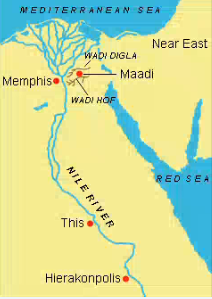

 The city of Memphis, located on the Nile near the modern city of Cairo, was founded around 3100 B.C. as the first capital of a recently united Egypt. The choice of Memphis by Egypt's first kings reflects the site's strategic importance. First, and most obvious, the apex of the Nile River delta was a politically opportune location for the state's administrative center, standing between the united lands of Upper and Lower Egypt and offering ready access to both parts of the country. The older predynastic (pre-3100 B.C.) centers of power, This and Hierakonpolis, were too remote from the vast expanse of the delta, which had been incorporated into the unified state. Only a city within easy reach of both the Nile valley to the south and the more spread out, difficult terrain to the north could provide the necessary political control that the rulers of early dynastic Egypt (roughly 3000-2600 B.C.) required.
The city of Memphis, located on the Nile near the modern city of Cairo, was founded around 3100 B.C. as the first capital of a recently united Egypt. The choice of Memphis by Egypt's first kings reflects the site's strategic importance. First, and most obvious, the apex of the Nile River delta was a politically opportune location for the state's administrative center, standing between the united lands of Upper and Lower Egypt and offering ready access to both parts of the country. The older predynastic (pre-3100 B.C.) centers of power, This and Hierakonpolis, were too remote from the vast expanse of the delta, which had been incorporated into the unified state. Only a city within easy reach of both the Nile valley to the south and the more spread out, difficult terrain to the north could provide the necessary political control that the rulers of early dynastic Egypt (roughly 3000-2600 B.C.) required.A.River-based trade from northern Egypt and imported goods going south all passed through the Memphis region, making Memphis an ideal location for controlling trade.
B.Recent geological surveys suggest that the topographical features of the Memphis region made it particularly well-suited for controlling communications and trade.
C.The rulers of unified Egypt enjoyed a monopoly over foreign trade because all such trade was required to go through the Wadi Digla, to which the rulers controlled all access.
D.After Memphis became the capital city, river-based trade along the Nile gained in importance, while land-based desert trade declined in importance.
E.The Nile, despite a constriction of its valley near Memphis, was the most advantageous route for communication and travel once the floodplain had begun to rise.
F.While the location of Memphis was agriculturally favorable, it was particularly attractive because it enabled Egypt's rulers to control trade moving through the desert from the Near East.

名师1对1,深度分析薄弱项,高效提分